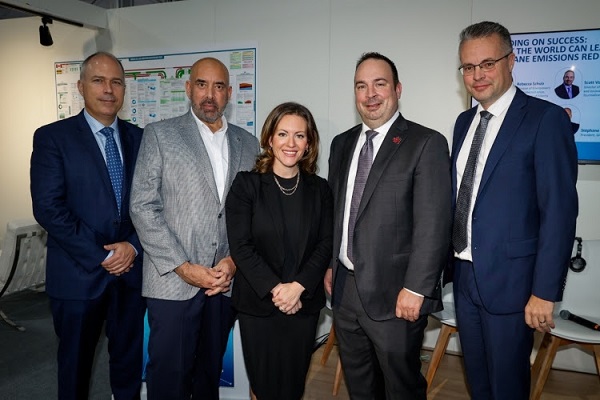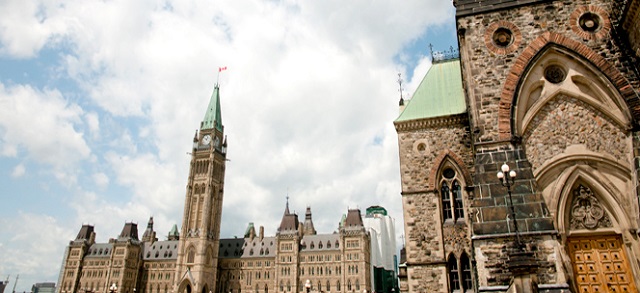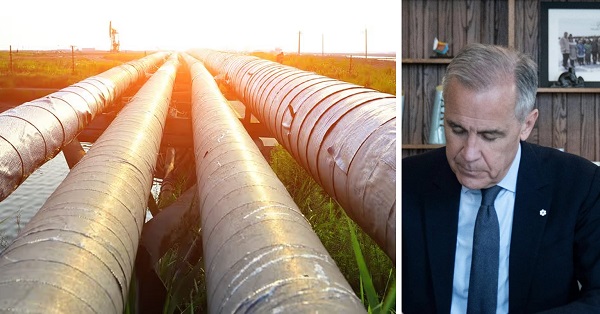Alberta
Turning resources into new jobs and products

(Left to right: Stéphane Germain, president of GHGSat; John Adams, president and CEO, NGIF Capital and NGIF Accelerator and managing partner of Cleantech Ventures; Rebecca Schulz, Minister of Environment and Protected Areas; Scott Volk, director of emissions and innovation, Tourmaline Oil; Justin Riemer, CEO of Emissions Reduction Alberta)
New funding will advance technologies that turn Alberta’s natural resources, such as bitumen, into materials of the future.
Alberta is Canada’s third-largest producer of manufactured goods and materials and first in clean technology innovation. At the same time, manufacturing companies around the world are looking for ways to make products like concrete, plastics, food, wood, chemicals and machinery more efficient, more durable, easier to recycle and better for the environment.
Alberta’s government is investing $40 million from the industry-funded Technology Innovation and Emissions Reduction (TIER) program to advance technologies that will turn everyday items that would otherwise be wasted or dumped in landfills into modern, low-emission products. These technologies will help create jobs, reduce emissions and help Alberta’s manufacturing industry lead the world.
“We have the resources, expertise and entrepreneurs needed to create some of the most advanced materials in the world. This funding competition will help develop new and exciting technologies that reduce emissions, create jobs, reuse waste and keep growing our economy.”
Advanced materials are increasing in global demand. They are new or significantly improved materials that provide a distinct advantage in performance when compared to conventional materials. Advanced materials have already been used to create new construction materials, improved batteries and fuel cells and lighter, stronger aircrafts, bicycles and golf clubs, among other products.
Led by Emissions Reduction Alberta, Alberta’s new funding competition will support scale-up, pilot, and demonstration and first-of-kind commercial technologies that improve the extraction, production, manufacturing, and performance of new and existing materials and products in Alberta. It is open to a wide a range of applicants including researchers, businesses, municipalities and Indigenous communities.
“Enhancing existing products and developing new materials with superior performance while embracing circular economy strategies will help deliver deeper emissions reductions, enhance supply chain resiliency and strengthen industrial competitiveness. This funding, sourced from Alberta’s TIER regulation, is critical and the possibilities are endless.”
The focus of this funding is to help create technologies that turn resources into modern, new products. This includes emerging technologies extracting high value metals like vanadium, titanium and lithium found within natural resources such as bitumen and creating novel, carbon-absorbing materials. These can then be used to improve everything from construction material and consumer electronics to aircrafts and hockey sticks.
“Emerging technology solutions, such as creating advanced carbon products from bitumen, are critical to lowering emissions and creating jobs in the province. Alberta Innovates is pleased to support this call and work closely with Emissions Reduction Alberta to realize a new future for Albertans.”
“By transforming our abundant natural resources into advanced, low-carbon materials, we are not only driving emissions reductions but also creating valuable opportunities for industry growth and export potential. The Government of Alberta’s investment through Emissions Reduction Alberta’s Advanced Materials Challenge demonstrates a commitment to building a resilient economy that harnesses Alberta’s strengths in new and sustainable ways.”
Quick facts
- Applications for the Advanced Materials Challenge close on Wednesday, January 22, 2025, at 5 PM MST.
- Successful applicants are eligible for up to $5 million.
- Applications are open to innovators, technology developers, commercial and industrial building owners, municipalities, Indigenous communities, small and medium-sized businesses, research and development organizations, universities, and not-for-profit organizations.
- Applications are open to emerging technologies. While technology solutions can originate from anywhere globally, they must be piloted, demonstrated or deployed in Alberta.
- The TIER system uses industry dollars to help Alberta facilities find innovative ways to reduce emissions and invest in clean technology to stay competitive and save money.
- Full details on the Advanced Materials Challenge can be found on Emissions Reduction Alberta’s website.
Related information
Alberta
Natural gas connection to breathe new life into former Alberta ghost town

From the Canadian Energy Centre
By Cody Ciona
Nordegg looks forward to lower energy costs and improved reliability
More than a century after its founding, the former ghost town of Nordegg, Alta. is getting natural gas service, promising lower costs and more reliable energy for homes and businesses.
“Natural gas will be a huge game changer, especially for commercial use,” said Clearwater County Reeve Michelle Swanson.
The former coal mining town is no stranger to cold winters. During Alberta’s cold snap in January 2024, the hamlet broke its cold weather record reaching a bone chilling -45.8 degrees Celsius.
In the 1920s, Nordegg — tucked into the foothills of the Rockies about two hours west of Red Deer — was home to Alberta’s most productive coal mine, a fuel supply primarily for steam locomotives.
But demand declined following the Leduc No. 1 oil discovery in 1947, and the mine closed in 1955.
The population dwindled from a peak of nearly 3,000 people to as few as 27 at one point, said Swanson.
Today, about 90 people call the hamlet home, and the future is looking brighter.
“We’re slowly building up. We have more full time residents. We have businesses that are looking to locate there, a couple hotels. Tourism is the area’s primary industry,” Swanson said.
By adding access to natural gas and installing new fibre optic internet, Nordegg will be able to sustain new growth and attract development, she said.
In July, the Alberta government announced $2.5 million in funding to help build an 11-kilometre pipeline connecting the hamlet to a nearby gas plant. The $8-million project is also funded by the county and the Rocky Gas Co-Op.
With the new gas connection, residents could save up to 25 per cent on their utility bills, according to the province.
Swanson said that right now people in Nordegg get their energy from electricity, wood and propane.
“Electricity is the primary heat source, and your secondary is wood stoves and most of the businesses are also running off propane, because of the costs of electricity,” she said.
The biggest benefit of connecting to natural gas is reliability, she said.
“Number one is having the predictability that gas provides. It is going to be there on time. Propane, I mean, you can run out,” Swanson said.
Safety is another big factor in a region that can be prone to wildfires.
“I know our firefighters were worried that a wildfire could set off a lot of propane explosions, and that’s not helpful,” she said.
“At the end of the day to me, it’s all about the fact that you’re creating a safer community, and you’re having a more predictable fuel source.”
Pipeline construction began in February and is targeted for completion this fall.
Alberta
Alberta’s fiscal update—and $6.5 billion deficit—underscores need for spending reductions

From the Fraser Institute
By Tegan Hill
According to the Q1 fiscal update, the Alberta provincial government will run a $6.5 billion budget deficit this fiscal year—up from the $5.2 billion budget deficit projected in the February budget. This may come as a surprise to many on the heels of a $8.3 billion surplus in 2024/25, but it’s all part of Alberta’s ongoing resource revenue rollercoaster. And it’s time to get off the track.
Resource revenues, including oil and gas revenues, are inherently volatile. For perspective, over roughly the last decade, resource revenue has been as low as $2.8 billion in 2015/16, accounting for just 6.5 per cent of total revenue, and as high as $25.2 billion in 2022/23, accounting for 33.2 per cent of total revenue.
Alberta has a long history of enjoying budget surpluses when resource revenue is high, but inevitably falls back into deficits when resource revenue declines. And it’s no surprise we’re back here today.
According to the recent fiscal update, resource revenue will fall by $6.3 billion this year compared to last. That means that of the $14.8 billion swing in Alberta’s budget balance, nearly 43 per cent can be explained by a decline in resource revenue alone. And if resource revenue was the same level as last year, Alberta’s budget would nearly be balanced.
Deficits have real consequences. Consider Alberta’s last period of deficits, which went on nearly uninterrupted from 2008/09 to 2020/21. Alberta moved from a position of having more assets, such as the Heritage Fund, than it did debt, resulting in a net debt position of $59.5 billion in 2020/21. Overall, Alberta’s net financial position deteriorated by $94.6 billion over the period. Correspondingly, Albertans went from having interest payments on provincial debt of approximately $58 per person in 2008/09 to $564 in 2020/21 (that number is expected to surpass $705 per person by 2027/28).
Fortunately, Alberta isn’t doomed to the boom and bust cycle.
The key is understanding that Alberta’s fiscal challenges are not actually a revenue problem—they’re a spending problem. Indeed, the underlying issue is that governments typically increase spending during good times of relatively high resource revenue to levels that are unsustainable (without incurring deficits) when resource revenue inevitably declines. Put simply, ongoing spending levels significantly exceed stable ongoing revenue.
The provincial government has made important strides in recent years by limiting spending growth to inflation and population growth. Unfortunately, spending levels were already so misaligned with stable, predictable revenue, that it is simply not sufficient to avoid deficits. Alberta needs meaningful spending reductions.
Fortunately, there’s some low hanging fruit to help get the province on track. For instance, Alberta spends billion of dollars annually dolling out subsidies to select businesses and industries. For perspective, in 2024/25, grants were the largest expense for the ministry of environment and the second largest expense for the ministry of technology and innovation. The provincial government should require that each ministry closely examine their budgets and eliminate business subsidies to yield savings.
According to the recent fiscal update, Alberta will continue to ride the resource revenue rollercoaster in 2025/26. It’s time to finally change course. That means meaningful spending reductions—and eliminating business subsidies is a good place to start.
-

 Business1 day ago
Business1 day agoBigger Government, Bigger Bill: PBO reveals $71.1 billion in federal personnel spending in 2024–25
-

 Alberta1 day ago
Alberta1 day agoNatural gas connection to breathe new life into former Alberta ghost town
-

 COVID-192 days ago
COVID-192 days agoRFK Jr. revokes emergency use authorization for COVID shots
-

 Alberta1 day ago
Alberta1 day agoAlberta’s fiscal update—and $6.5 billion deficit—underscores need for spending reductions
-

 Business1 day ago
Business1 day agoCanadians can’t afford another Ottawa budget failure
-

 Crime2 days ago
Crime2 days agoPolice Say Victim Drugged, Kidnapped From Alberta in B.C. Human Trafficking and Cocaine Dealing Network
-

 Daily Caller14 hours ago
Daily Caller14 hours agoHUD Secretary Says Illegals May No Longer ‘Live In Taxpayer-Funded Housing’
-

 Energy1 day ago
Energy1 day agoGuess there’s a “business case” after all. Europe wants LNG, but can Canada still provide it?







